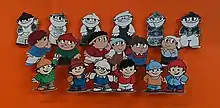Mainzelmännchen
The Mainzelmännchen are six comedic cartoon characters used as mascots for German public service television broadcaster ZDF. They first aired on television in 1963 as a way to accommodate a government regulation disallowing confusion between advertising and commercials. The cartoon characters served as a transition between the two.[1]

They appear in between ads during broadcast, in roughly three to five second clips, and often during the satirical news program Heute-show. The name is a combination Mainz, headquarters for ZDF, and Heinzelmännchen, a type of gnome common in folklore surrounding the city of Cologne. Wolf Gerlach created the characters.[2][3]
The Mainzelmännchen have become quite popular across Germany. Radio dramas have been created surrounding them, as well as children's books, and numerous other kinds of merchandise.
The series also aired in the United Kingdom on BBC TWO in 1964 until 1999.
Appearance and Actions
The Mainzelmännchen are either Wights or Dwarves, and express similarities to Heinzelmännchen. They often wear a Phrygian cap, similar to garden gnomes, however lack a beard. Their appearances often last three to five seconds, where they perform a single short gag. They usually speak in only a few short words, in a grumbly tone. Many of the gags are presented only visually and pantomimically. Their most famous saying is the traditional greeting „Gud’n Aamd“, a dialect coloured "Guten Abend" ("good evening"). Their given names are Anton, Berti, Conni, Det, Edi and Fritzchen.
References
- "Who are those Cartoon Men on German TV? The Mainzelmännchen!!!". A German Girl in America. 2018-01-26. Retrieved 2021-05-29.
- "Die Mainzelmännchen". www.zdf.de (in German). Retrieved 2020-05-18.
- "ZDF Werbefernsehen: Die Mainzelmännchen". www.zdf-werbefernsehen.de. Retrieved 2020-05-18.